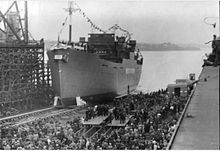Avondale Park
|
||||||||||||||||||
|
||||||||||||||||||
|
||||||||||||||||||
The Avondale Park was a British steamship ( prefix SS for English Steam Ship ), which was built during the Second World War for the Canadian government , and then performed vital services as a cargo ship under the British flag . It was sunk on the last day of the war in the Firth of Forth by the torpedo of a German submarine .
fate

The ship was in May 1944 at the Canadian shipyard Pictou Shipyard (picture) in Pictou ( Nova Scotia ) from the stack . From then on, it served the Allies as a freighter for goods essential to the war effort.
On May 7, 1945, the day of the unconditional surrender of the Wehrmacht , Avondale Park was part of the British convoy EN 491 . It left the port of Methil on the same day (picture) , a small Scottish town in the Council Area Fife south of the confluence of the Leven in the Firth of Forth. To convoy belonged next to the Avondale Park four other merchant ships, namely the British freighter also Weybank and the three Norwegian ships Rolf Jarl , Selvik and Sneland I . In view of the imminent end of the war, the convoy drove without escort. His destination was Belfast .
In the late evening of the day the convoy was sighted by the German submarine U 2336 near the Isle of May at the exit of the Firth of Forth (map) . This was a relatively small, but at the time ultra-modern submarine of the Type XXIII with a crew of only 14 men and an armament of only two torpedoes. The commander , Kapitänleutnant (KptLt.) Emil Klusmeier (1912–1982), had a torpedo fired at around 10:30 p.m. on the Avondale Park and the Sneland I (1791 BRT ). The first torpedo hit Avondale Park while Sneland I was still changing course to avoid a collision with her. But only a few minutes later, between about 10:40 p.m. and 10:45 p.m., she was also hit on the starboard side and sank within just two minutes ( 56 ° 10 ′ N , 2 ° 31 ′ W ). Here, seven crew members including the captain of the died Sneland I .
Shortly after 11 p.m., Avondale Park ( 56 ° 5 ′ N , 2 ° 32 ′ W ) also sank . Two British seamen, chief engineer George Anderson and seaman William Harvey, died. The remaining crew members could be saved. Avondale Park is the last ship ever to go down due to a German submarine during World War II.
literature
- Eberhard Rössler : submarine type XXIII. 2nd, expanded edition. Bernard & Graefe, Bonn 2002, ISBN 3-7637-6236-1 , pp. 109-112.
- Eberhard Rössler: From the original to the model. Submarine type XXIII. A picture and plan documentation. Bernard & Graefe, Bonn 1993, pp. 37-38, ISBN 3-7637-6007-5 .
Web links
- Commemorative plaque in Anstruther, Scotland, in memory of the two sailors who perished in the sinking of Avondale Park and all allied victims of the Battle of the Atlantic , (English), accessed on April 18, 2018.
- Avondale Park on uboat.net , accessed on April 18, 2018.
- SS Avondale Park at WreckSite.eu , accessed April 18, 2018.
Individual evidence
- ↑ Avondale Park in Lloyd’s Ship Register , accessed April 18, 2018.
- ↑ Report on the Sneland I (English), accessed on 18 April 2018th
- ^ Vessels Lost in WW2 Recorded on the Memorial at Tower Hill (English), accessed April 18, 2018.
- ^ Jürgen Rohwer , Gerhard Hümmelchen : Chronicle of the Sea War 1939–1945, May 1945 , accessed on April 18, 2018.

